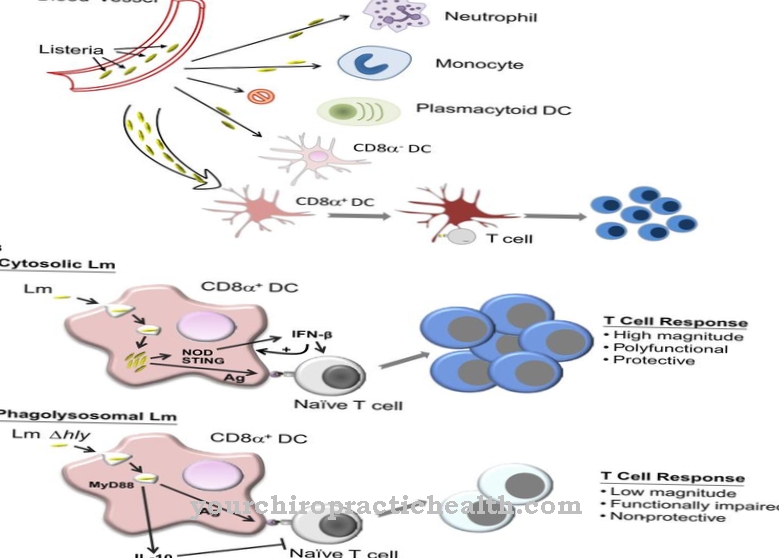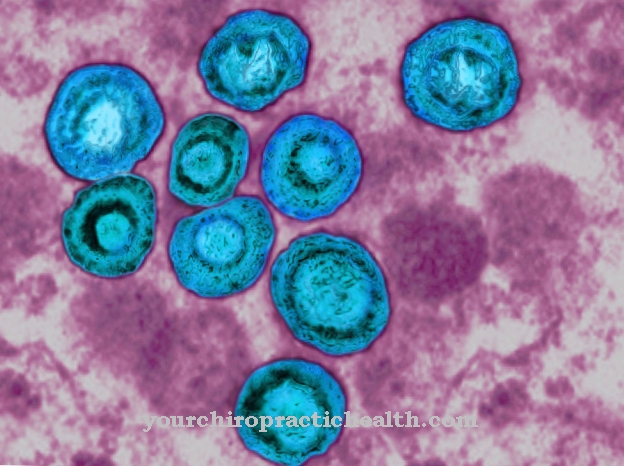The Hepatitis C virus is an RNA virus that occurs worldwide. It causes hepatitis C.
What is the hepatitis C virus?
The hepatitis C virus (HCV) is an enveloped virus with a single strand of RNA. It belongs to the Flaviviridae family and to the hepacivirus genus. The virus with the positive polarity is the only known RNA virus, with the exception of the retroviruses, which can cause a chronic infectious disease.
The virus was first mentioned in 1974 as the non-A-non-B hepatitis virus. However, it was not until 1989/1990 that the pathogen was sequenced and henceforth called the hepatitis C virus. The entire genome frequency of the virus is subject to patent protection. The patent holder is currently the pharmaceutical company Novartis.
Together with the Epstein-Barr virus, the causative agent of Pfeiffer's glandular fever, the hepatitis B virus and the human herpes virus 8, the HCV is one of the viruses that are responsible for most cancers worldwide. Around 10 to 15 percent of all cancers are caused by infection with these human viruses.
Occurrence, Distribution & Properties
Humans are the only natural hosts of the hepatitis C virus. Monkeys can also be infected, but very rarely develop a chronic infection. The virus is spread all over the world. The World Health Organization (WHO) estimates that there are more than 170 million virus carriers. The disease does not break out in all carriers, so the number of sufferers is slightly lower.
The prevalence is highest in countries like Japan, Egypt or Mongolia. In Egypt, for example, the high prevalence rate is due to contaminated cannulas used in the treatment of schistosomiasis. Schistosomiasis is a worm disease that is spread by intermediate hosts in warm inland waters. In Europe and the US, the prevalence rate is less than 0.02. While subtypes 1a, 1b and 3a are mainly found in Europe and America, subtype 1b dominates in Asia. Genotype 4 predominates in Africa, genotype 6 in Hong Kong and Vietnam. Genotypes 2 and 3 are found worldwide, but are represented to a lesser extent.
The hepatitis C virus is transmitted parenterally. Parenteral means "bypassing the bowel". The infection usually occurs through contaminated blood products or blood. Sexual transmission is extremely rare. Intravenous drug abuse, piercings and tattoos are considered risk factors for infection with the hepatitis C virus. Dialysis is also a risk factor. This is especially true for dialyses that were carried out before 1991. Before 1991, the virus had not yet been sequenced, so it could not be detected. In a third of patients, the route of transmission is unknown.
Illnesses & ailments
In the acute phase, hepatitis C is usually asymptomatic or accompanied by few symptoms. In 85 percent of all cases of infection, the disease is therefore not diagnosed in the early stages. After an incubation period of two weeks to two months, those affected suffer from exhaustion, tiredness or loss of appetite. The joints may be painful or the infected may feel a feeling of tension or pressure in the right upper abdomen. Jaundice develops in a few people affected. Due to liver damage, the urine may be dark and the stool may be clay-colored. If these typical liver symptoms are absent, most of the sick people perceive the illness as a mild flu-like infection in the acute phase.
In more than 70 percent of all cases of illness, however, hepatitis C takes a chronic course after the acute phase. If left untreated in the chronic stage, the infection leads to cirrhosis of the liver in 25 percent of patients. Liver cirrhosis is characterized by chronic degeneration of liver tissue. This creates a nodular tissue structure in the liver that severely restricts the function of the organ. In addition, more connective tissue is formed instead of the liver function cells.
The function of the liver can be restricted in terms of its synthesis function by albumins and / or coagulation factors. The result is an increased tendency to bleed and the formation of edema.Typical symptoms of liver cirrhosis are also ascites, enlarged spleen, reddening of the palms, a red lacquer tongue and caput medusae, a clear vascular mark on the abdomen.
Liver cirrhosis is also a so-called facultative precancerous condition. This means that a malignant cancer can develop from cirrhosis. This malignant tumor of the liver tissue is known as hepatocellular carcinoma (HCC).
In the course of hepatitis C, other antibody-mediated diseases can also develop. This includes, for example, cryoglobulinemia. It is an inflammation of the blood vessels (vasculitis) that is associated with joint pain, muscle pain and neuropathies. Polyarteritis nodosa is also a vasculitis that can develop on the basis of hepatitis C. Those affected experience unspecific symptoms such as fever, night sweats and weight loss. The majority of those affected also suffer from nerve disorders. Involvement of the CNS (central nervous system) with [stroke, strokes]] is also possible.
Hepatitis C can also cause Sjogren's syndrome. Sjogren's syndrome belongs to the group of collagenoses. In this disease, the immune cells attack the lacrimal glands and the salivary glands and cause inflammatory changes in the central nervous system and internal organs.
There are also established causal relationships between hepatitis C and insulin resistance, diabetes mellitus and depressive symptoms. Standard therapy for hepatitis C is a combination of various antivirals. Different drugs are used depending on the genotype. In the treatment of hepatitis C, severe side effects are to be expected.
























.jpg)



